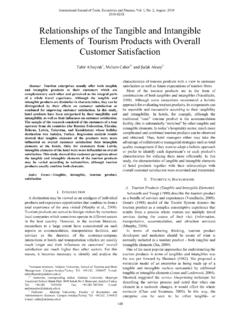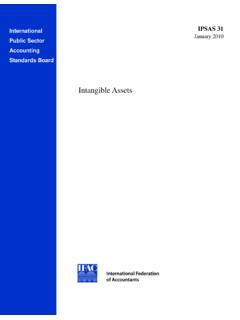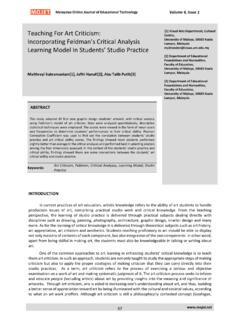Transcription of Defining Innovation
1 Innovation is about helping organizations grow. Growth is often mea-sured in terms of turnover and profit, but can also occur in knowledge,in human experience, and in efficiency and quality. Innovation is theprocess of making changes to something established by introducing some-thing new. As such, it can be radical or incremental, and it can be appliedto products, processes, or services and in any organization. It can happenat all levels in an organization, from management teams to departmentsand even to the level of the chapter describes the main concepts behind Innovation . Weexplore the different types of Innovation that affect the growth of anorganization.
2 The difference between radical and incremental innovationis discussed, as is the special relationship between product and you have completed this chapter you will be able to Define Innovation and explain the difference with related terms Understand the drivers of the need for Innovation and change Explain product, process, and service Innovation Describe the difference between radical and incremental Innovation Define disruptive technology Show how product and process innovations are related Explain the relationship between Innovation and operations31 Defining Innovation01-O'Sullivan ( Innovation )-45628:01-O'Sullivan ( Innovation )-45628 5/29/2008 10:27 AM Page 3 Definition of InnovationInnovation has been and continues to be an important topic of study for anumber of different disciplines, including economics, business, engineer-ing, science, and sociology.
3 Despite the fact that Innovation has been stud-ied in a variety of disciplines, the term is often poorly understood and canbe sometimes confused with related terms such as change, invention, design,and creativity. Most people can provide examples of innovative productssuch as the iPod or the PC, but few can clearly define the inno vativeaspects of these products. Among academics there is a difference of opin-ion about what the term Innovation really means. One definition of inno-vationtaken from the dictionary that fits the ideas and concepts used in thisbook is the following (The New Oxford Dictionary of English,1998, p.)
4 942):Making changes to something established by introducingsomething definition does not suggest that Innovation must be radical or thatit occurs exclusively to products. Nor does it suggest that Innovation isexclusively for large organizations or single entrepreneurs. Nor does it sug-gest that it is exclusively for profit-making businesses; Innovation is as rel-evant for a hospital or local government as it is for a business. In theorganizational context Innovation can occur to products, processes, or ser-vices. It can be incremental or radical, and it can occur at various levels inan organization, from management groups and departments to projectteams and even is the general concept of Innovation as discussed in this book.
5 Wewill see later that the fundamental concepts of Innovation as they arederived from this definition are universally relevant for all organizations,from private companies such as Nokia down to public organizations suchas hospitals. Innovation is a process that transforms ideas into outputs,which increase customer value. The process can be fed by both good andbad ideas. In management of the Innovation process, destroying poorideas often is as important as nurturing good ones; in this way, scarceresources can be released and good ideas spotlighted. Every good ideausually replaces an older established one.
6 The goal of every organization isthe successful development of good ideas. To express this development ofgood ideas in Innovation , we need to add an addendum to our definition: Innovation is the process of making changes to something establishedby introducing something new that adds value to addendum is important. By describing an Innovation as addingvalue to customers, we assume naturally that customers who experiencethe added value will continue to use the product, process, or service or at4 PART I UNDERSTANDING INNOVATION01-O'Sullivan ( Innovation )-45628:01-O'Sullivan ( Innovation )-45628 5/29/2008 10:27 AM Page 4least have an improved experience.
7 This in turn will lead to growth for theorganization. Innovation management is the process of managing innova-tion within an organization. This includes activities such as managingideas, Defining goals, prioritizing projects, improving communications,and motivating teams. As we will see later, innovations have particular lifecycles; today s Innovation will become obsolete in the future. For organi-zations to sustain their mission, they must continuously innovate andreplace existing products, processes, and services with more effective on Innovation as a continuous process acknowledges the effectthat learning has on knowledge creation within the organization.
8 Learninghow to innovate effectively entails managing knowledge within the orga-nization and offers the potential to enhance the way the organizationinnovates. This element adds a further extension to our definition: Innovation is the process of making changes to something establishedby introducing something new that adds value to customers andcontributes to the knowledge store of the concept of an organization s knowledge store is partially synony-mous with the concept of organizational learning. An organization thatcan continuously learn and adapt its behavior to external stimuli does soby continuously adding to its collective knowledge store.
9 The emergingperspective by specialists in the field of Innovation is to define innovationin the broadest context possible. One reason for this is that if it is definedtoo narrowly, it may limit creativity by excluding certain avenues of inves-tigation. Innovation is linked to the concepts of novelty and , novelty is highly subjective. What may be a trivial change for oneorganization may be a significant Innovation for another. Based on thisperspective, we can further extend the definition of Innovation as follows: Innovation is the process of making changes, large and small,radical and incremental, to products, processes, and services thatresults in the introduction of something new for the organizationthat adds value to customers and contributes to the knowledgestore of the latter definition, although general, is specific enough to illustrate anumber of core concepts of Innovation as applied in any Innovation , which is the main focus of this book.
10 Can be definedby adding a number of key words to the preceding Innovation is the application of practical tools andtechniques that make changes, large and small, to products,processes, and services that results in the introduction ofsomething new for the organization that adds value to customersand contributes to the knowledge store of the 1 Defining Innovation501-O'Sullivan ( Innovation )-45628:01-O'Sullivan ( Innovation )-45628 5/29/2008 10:27 AM Page 5 Related ConceptsInnovationis often used in conjunction with terms such as creativity,design, invention,and exploitation. It is also closely associated with termssuch as growthand change.












